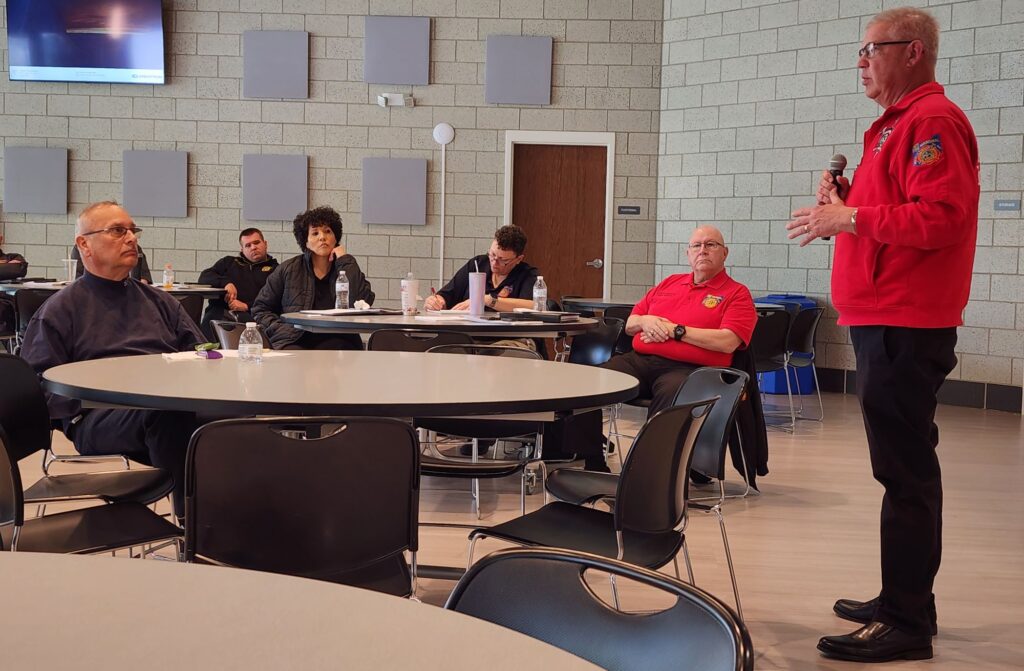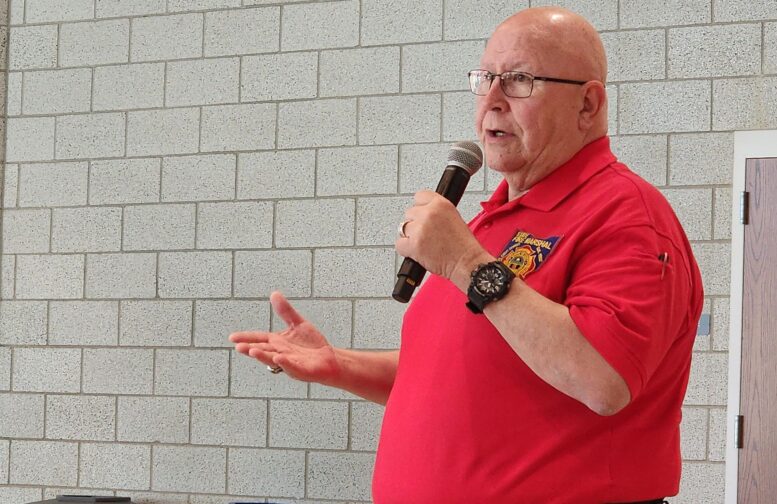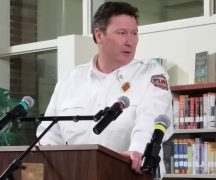By JAN McLAUGHLIN
BG Independent News
In addition to battling blazes, firefighters in Ohio also have to fight for funding from the state and defend fire code regulations written to keep Ohioans safe.
State Fire Marshal Kevin Reardon and members of his staff were in Bowling Green on Thursday, offering their services to fire departments in the region that face growing run loads, increasing training requirements, and escalating equipment costs.
Twice during the two-hour meeting, Bowling Green firefighters’ radios went off, calling them to emergencies. The first was for a person experiencing chest pains, the second for a person suffering a traumatic brain injury due to a fall.
Each time, Reardon reminded the firefighters, “Be safe out there,” as they headed to the calls.
As state fire marshal, Reardon no longer responds on fire runs, but he battles to keep firefighters safe on the job. But the state doesn’t make it easy.
Reardon is currently working on the state fire code that gets revised every five years. This is the first revision since Ohio legislators adopted a requirement that every time a new regulation is added to state code, two existing regulations must be removed.
That just doesn’t make sense with fire safety regulations, Reardon said.
“It’s been very difficult,” he said. “It’s a very awkward process – we’re talking about public safety.”
Ohio legislature members recently introduced the process of getting rid of sprinkler requirements in some places of public assembly. Reardon vehemently opposed, and Gov. Mike DeWine vetoed the plan.
“People died in the past,” Reardon said, explaining the reason for the sprinkler requirements. “Our mission is to save the lives of Ohioans, not put them more at risk.”

The firefighting profession has little clout with the state legislature, Reardon said, citing the 2022 passage of a bill allowing consumer grade fireworks to be sold in Ohio, despite overwhelming opposition by fire departments and no funding to hire fire marshal staff to handle fireworks issues.
On the other hand, law enforcement in Ohio has huge legislative support, Reardon said as he stretched out his arms to emphasize money sent to law enforcement agencies. Meanwhile, fire departments get miniscule support, he said, measuring an inch.
“We all love our brothers and sisters in blue,” Reardon stressed. But he would love similar support for those in his profession.
Meeting the training requirements for firefighting doesn’t come cheap, and unlike policing, the cost has been borne by the fire departments or the individual firefighters.
“Everybody is sensitive to the needs of law enforcement,” Reardon said, but fire departments are also having difficulties with recruitment and retention.
Meanwhile the cost of equipment and personnel continue to grow.
“It never comes down. It always goes up,” Reardon said.
Bowling Green Fire Chief Bill Moorman knows that firsthand. With more fire and EMS calls, more staff is needed to respond. And more training and frequent refresher courses are needed for a variety of skills like fighting fires, dealing with hazardous materials, auto extrication, confined space rescues, plus water and ice rescues.
“It’s expensive to run a fire department,” Moorman said.
The cost of equipment continues to climb, he added. The new fire truck, already equipped, delivered to BGFD last year cost $760,000. Another one, not equipped, to be delivered at the end of this year will cost $860,000.
When Moorman first began investigating the replacement of BGFD’s one aerial fire truck six years ago, the cost was estimated at $1.2 million. Now the cost is estimated at $2.1 million – with a three-year delivery date.
“It’s not like going to a car lot and picking out a new car,” he said.
The inequity is state support is frustrating to many in the fire service.
“It really needs to change,” Moorman said. “It needs to be addressed by our legislators.”
The funding issue is dire at many of the volunteer fire departments in Ohio – with 70% of the 1,178 fire departments being staffed by volunteers.
Those stations are barbecuing chicken, frying fish, and cooking spaghetti dinners to keep their departments afloat, Reardon said.
“It’s 2024, we can do better,” he said.
Reardon told of two volunteer firefighters in Fayette County working on the antennae atop their fire station, two days after Thanksgiving last year. The lift they were using malfunctioned, thrusting them to the ground, killing both.
“They died for a job that pays nothing,” trying to save the fire department money by doing repairs themselves, Reardon said.
Fire departments are fighting for the same tax dollars that many entities compete for, trying to pass tax levies.
“Everybody wants a piece of that dollar,” Reardon said. “But safety has never had an economic price tag.”
So the state fire marshal’s office travels through Ohio, offering support to fire departments.
“There are ways we can help them in ways they may not have known,” Reardon said. The fire marshal’s bureaus offer code enforcement, fire and explosion investigations, fire prevention, a forensic fire laboratory, underground storage tank regulations, testing, and the Ohio Fire Academy.

Tom Bentley, of Wayne, coordinates training trailers that can be brought to fire departments in Northwest Ohio. He spoke at Thursday’s meeting about training options.
Reardon reported on his plans to improve the state fire school in Reynoldsburg. The training site has not seen any significant updates in the past 50 years, he said. And until two months ago, the site had no house fire practice facility, despite the fact that 95% of fire responses are at houses.
DeWine is reportedly in support of an $89 million upgrade over 10 years of the training grounds. But now, Reardon needs to find legislative support.
“Ohio’s firefighters deserve it. Our citizens deserve it,” he said.
Moorman credited Reardon for the costs now being cut in half to send personnel to the state fire school, and for securing funding for MARCS radios for fire departments.
“He’s definitely an advocate of the fire service,” Moorman said of Reardon.





